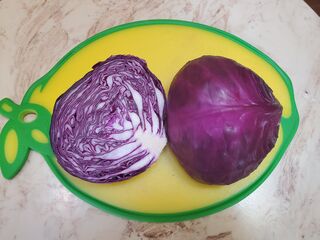

Red cabbage is a powerful antioxidant and is packed with essential nutrients.
Key points
- Research shows several health benefits of consuming red cabbage.
- Red cabbage makes for tasty prebiotics.
- Red cabbage is in season now and is delicious raw in salads and in cooked dishes.
Many health professionals, myself included, believe that food is our medicine, which is why we must consider nutrition in any discussion of our health. Proper nutrition is essential for our body, brain and well-being. There are many varieties of food that are good for us and in my blog I have written about some of them. Today’s topic is red cabbage, because it has many important health benefits and is in season now (September to December). It is also very tasty and one of my favorite veggies.
Cabbage is a cruciferous vegetable. This means that it belongs to the Brassicacae family, which includes broccoli, cauliflower, kale, radishes and others. There are over 400 different varieties of cabbage. The most popular are green, white and red cabbage. The last one has the most health benefits. Red cabbage (also called purple cabbage) has 10 times more vitamins and nutrients than green cabbage.

Source: Barbara Koltuska-Haskin
The Health Benefits of Red Cabbage
Red cabbage is one of the best sources of dietary flavonoids, which are powerful antioxidant agents. It also has anti-inflammatory and antiviral properties, which means that it may help prevent chronic diseases.
Red cabbage is packed with vitamins and minerals. It is rich in Vitamin C (which boosts the immune system and stimulates the activity of white blood cells), Vitamin K (which is important for blood clotting, brain health and building healthy bones) and Vitamin B6 and folate (important for energy metabolism and normal functioning of the nervous system). It also contains Vitamin A (important for eye health) and E (a powerful antioxidant).
Regarding minerals, red cabbage contains calcium, magnesium, potassium, manganese and zinc. All of them are important for healthy bones and teeth.
Red cabbage is powerful brain food. It contains the antioxidant anthocyanin, which boosts mental function and concentration. It is also rich in the mentioned above Vitamin K, which contributes to brain function, has a modulatory role in cognition and may prevent dementia.
Red cabbage is a good source of dietary fiber, has low calories and high water content; therefore, is a good choice of food for weight loss. It is also good for people with diabetes because it has multi-target effects on glucose homeostatic regulation.
How to eat red cabbage
Red cabbage is delicious raw or cooked. It can be used in fall salads and in combination with fruits (apples or pears) or added to coleslaw. It can be roasted or cooked. It makes a very easy side dish when lightly steamed. It can be added to soups or stews. When fermented, it makes very healthy and tasty prebiotics (food for your gut bacteria). A recipe for red cabbage prebiotic is in my book How My Brain Works, too. Bon Appetite!
 Barbara Koltuska-Haskin, Ph.D., is a neuropsychologist in private practice in Albuquerque, New Mexico with over 30 years of clinical experience, and the author of How My Brain Works: A Guide to Understanding It Better and Keeping It Healthy. Her book has won 2 International Book Awards and 5 National Book Awards.
Barbara Koltuska-Haskin, Ph.D., is a neuropsychologist in private practice in Albuquerque, New Mexico with over 30 years of clinical experience, and the author of How My Brain Works: A Guide to Understanding It Better and Keeping It Healthy. Her book has won 2 International Book Awards and 5 National Book Awards.








Comments
Post a Comment